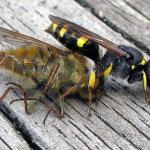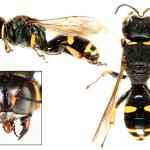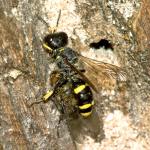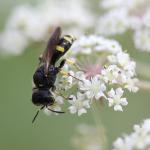Crabro bizexmaculatus (VIERECK,1910); Crabro fuscitarsis (HERRICH-SCHÄFFER,1841); Solenius giffardi (ROHWER,1917); Crabro granulates (WALKER,1871); Crabro pumilus (COSTA,1871); Crabro rugopunctatus (TASCHENBERG,1875); Crabro sayi (COCKERELL,1910); Crabro sexmaculatus (SAY,1824); Crabro vagatus (SMITH,1869); Ectemnius vagus misident.; Crabro validus (DE STEFANI PEREZ,1884)
The larger and more frequent of the two British species of Ectemnius with reduced yellow spots on gastral terga 1 and 3 (subgenus Hypocrabro).
Widely distributed in Britain as far north as Fifeshire. Information for Ireland is sparse but may reflect the lack of recording there. Very extensive overseas distribution covering subtropical, temperate and subarctic regions in the northern hemisphere.
One of the most common Ectemnius species, especially in the south. This species is not regarded as being scarce or threatened.
Can be encountered in a wide variety of habitats ranging from rides and clearings in woodlands through to intensive farmland, urban locations, wetlands and coastal habitats. Perhaps most frequent where abundant supplies of dead wood and umbellifer flowers are available.
Univoltine; early May to late September with records predominantly in June, July and August. In southern Britain, however, the species is almost certainly bivoltine (G R Else pers. comm.).
Prey consists of flies, especially medium-sized cyclorrhaphan flies such as syrphids, muscids and calliphorids, though tabanids and therevids are also listed by Lomholdt (1975-76).
Nests are found in burrows within dead wood such as old tree stumps, fallen trunks and limbs, fence posts, even building timbers. The burrow system varies depending on the nature of the wood in which it is constructed and may be straight or branched and consists of up to ten cells. These are each provisioned with six to eight flies (Lomholdt, 1975-76). The larva has been described by Evans (1964).
Adults show a strong attraction to the flowers of umbellifers such as angelica, hogweed, wild carrot, wild parsnip, fennel, hedge-parsley and water-dropwort, which appear to act both as a source of prey and nectar. Other flower visiting records include thistles, ragworts, yarrow and spurges.
No published data, though cleptoparasites are likely to include anthomyiid flies of the genus Eustalomyia, which are often found close to the nests, and possibly sarcophagid flies of the genera Amobia and Macronychia.
1998





